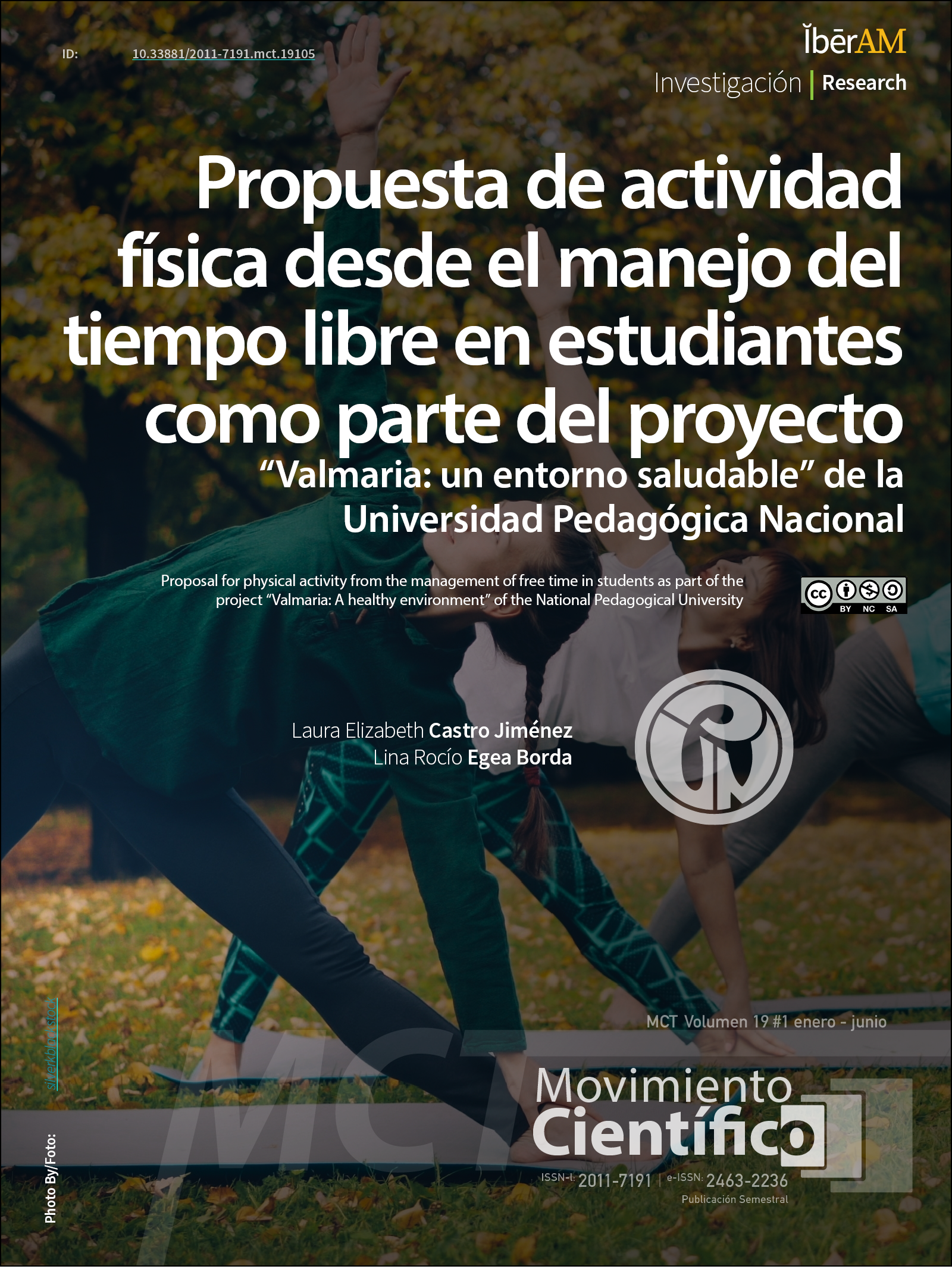Proposal for physical activity from the management of free time in students as part of the project:
Propuesta de actividad física desde el manejo del tiempo libre en estudiantes como parte del proyecto:“Valmaria: Un entorno saludable” de la Universidad Pedagógica Nacional "Valmaria: A healthy environment" of the National Pedagogical University
Main Article Content
Free time is considered a time when people carry out activities to enhance their skills and promote the development of their personality. Due to academic and in some cases work obligations, this time is limited for university students. Objective. To develop a proposal for physical activity from the management of free time in students of the National Pedagogical University through the identification of the ways in which the university population takes advantage of their free time. Materials and methods. Two-phase research was proposed, in the first phase a quantitative descriptive cross-sectional study was carried out composed of 1015 students between 18 and 26 years old. The "Healthy Lifestyle Questionnaire - CEVS" of 34 questions was applied, but only four questions were determined as determinants to know the management of free time, through a bivariate analysis using odds ratio (OR) and Chi2. In the second phase, based on a mixed study resulting from quantitative analyses and perceptions of preferences and barriers to the practice of physical activity in students' leisure time through focus groups, a proposal for physical activity from the management of free time was proposed. Results. A notable difference was found in the enjoyment of free time according to gender, evidencing a statistically significant difference, while the social factor has a similar result for men and women. A proposal was put forward that contains three components: i) promotion of healthy habits, ii) directed and recreational physical activities, and iii) optimization of free time. Conclusion. By identifying that PA is not a priority, but that both genders seek company and bonding, the need to design inclusive and adapted programs is underlined. In particular, it is crucial to offer women spaces that address mental health aspects such as self-acceptance, stress and anxiety management, thus improving their quality of life and academic performance.
Downloads
Publication Facts
Reviewer profiles N/A
Author statements
Indexed in
-
—
- Academic society
- N/A
- Publisher
- Bogotá: Corporación Universitaria Iberoamericana
Article Details
Brunet, J., & Sabiston, C. M. (2011). Social physique anxiety and physical activity: A self-determination theory perspective. Psychology of Sport and Exercise, 12(2), 167-176. https://doi.org/10.1016/j.psychsport.2010.10.002 DOI: https://doi.org/10.1016/j.psychsport.2010.10.002
Cairney, J., Veldhuizen, S., & King-Dowling, S. (2019). Gender, body mass index, and cardiorespiratory fitness in children and adolescents. Journal of Science and Medicine in Sport, 22(5), 523-528. https://doi.org/10.1016/j.jsams.2018.12.007 DOI: https://doi.org/10.1016/j.jsams.2018.12.007
Gómez-López, M., Granero-Gallegos, A., & Baena-Extremera, A. (2017). Barriers to participation in physical activity and sport in university students. Journal of Human Kinetics, 59(1), 45-52. https://doi.org/10.1515/hukin-2017-0148 DOI: https://doi.org/10.1515/hukin-2017-0148
Herrera-Pinzón, M. A., Castro-Jiménez, L. E., Herreño-Rodríguez, D. E., Argüello-Gutiérrez, Y. P., Aguirre-Rueda, D. M., & Sánchez-Rojas, I. A. (2023). Confiabilidad del cuestionario de estilos de vida saludable (CEVS) en estudiantes universitarios: Reliability of the healthy lifestyles questionnaire (CEVS) in university students. Peruvian Journal of Health Care and Global Health, 7(2). https://doi.org/10.37773/psgh.v7i2.101
Hills, A. P., Dengel, D. R., & Lubans, D. R. (2015). Supporting public health priorities: Recommendations for physical education and physical activity promotion in schools. Progress in Cardiovascular Diseases, 57(4), 368-374. https://doi.org/10.1016/j.pcad.2014.09.010 DOI: https://doi.org/10.1016/j.pcad.2014.09.010
Janssen, I., Roberts, K. C., & Thompson, W. (2017). Adherence to the 24-hour movement guidelines among 10- to 17-year-old Canadians. Health Reports, 28(10), 3-7. https://www150.statcan.gc.ca/n1/pub/82-003-x/2017010/article/54858-eng.htm DOI: https://doi.org/10.24095/hpcdp.37.11.01
Kretchmar, R. S. (2008). Practical philosophy of sport and physical activity. Human Kinetics.
López-González, M. M., Benavides-Ponce, M. F., & Buitrago-Montoya, R. M. (2023). Tensiones en cotidianidad de jóvenes universitarios: estudio en tres universidades del Quindío. Revista Latinoamericana de Ciencias Sociales, Niñez y Juventud, 21(3), 400-418. DOI: https://doi.org/10.11600/rlcsnj.21.3.6050
Ministerio de Salud y Protección Social. (2013). Plan Decenal de Salud Pública 2012-2021. Bogotá D.C.: Ministerio de Salud y Protección Social. Recuperado de https://www.minsalud.gov.co/sites/rid/Lists/BibliotecaDigital/RIDE/VS/ED/PSP/PDSP.pdf
Molano-Tobar, Nueva Jersey, Vélez-Tobar, RA y Rojas-Galvis, EA (2019). Actividad física y su relación con la carga académica de estudiantes universitarios. Hacia la Promoción de la Salud , 24(1), 112-125. DOI: https://doi.org/10.17151/hpsal.2019.24.1.10
Organización Mundial de la Salud. (2022). Informe sobre la situación mundial de la actividad física 2022. Ginebra: OMS. Recuperado de https://www.who.int/es/publications/b/66324
Peresini, V., & Hunziker, C. I. (2021). Obesidad, una mirada desde la epidemiología crítica. Archivos de Medicina Familiar y General, 18(1).
Plotnikoff, R. C., Costigan, S. A., Williams, R. L., Hutchesson, M. J., Kennedy, S. G., Robards, S. L., ... & Germov, J. (2015). Effectiveness of interventions targeting physical activity, nutrition and healthy weight for university and college students: a systematic review and meta-analysis. International Journal of Behavioral Nutrition and Physical Activity, 12, 1-10. DOI: https://doi.org/10.1186/s12966-015-0203-7
Ridgers, N. D., McNarry, M. A., & Mackintosh, K. A. (2016). Feasibility and effectiveness of using wearable activity trackers in youth: a systematic review. JMIR mHealth and uHealth, 4(4), e6540. DOI: https://doi.org/10.2196/mhealth.6540
Ruiz-Juan, F., & García-Moya, I. (2019). Tiempo libre, actividad física y bienestar en adolescentes: Análisis desde la teoría del comportamiento planificado. Revista Internacional de Medicina y Ciencias de la Actividad Física y del Deporte, 19(76), 641-656. https://doi.org/10.15366/rimcafd2019.76.010 DOI: https://doi.org/10.15366/rimcafd2019.76.006
Sallis, JF, Floyd, MF, Rodríguez, DA & Saelens, BE (2016). Papel de los entornos construidos en la actividad física, la obesidad y las enfermedades cardiovasculares. Circulation , 125(5), 729–7https://doi.org/1/CI.110.9
Van Der Horst, K., Paw, MJMCA, Twisk, JWR y Van Mechelen, W. (2007). Una breve revisión sobre los correlatos de la actividad física y el sedentarismo en la juventud. Medicina y ciencia en deportes y ejercicio, 39 (https://doi.org/10.1249/mss.0b013.0b013e318059bf35
Vidarte-Claros, J. A., García-Jiménez, E., & Crissien-Quiroz, J. D. (2018). Evaluación de los niveles de actividad física en universitarios y su relación con variables sociodemográficas y antropométricas. Revista de Salud Pública, 20(5), 606-611. DOI: https://doi.org/10.15446/rsap.v20n5.59003
Warburton, D. E. R., & Bredin, S. S. D. (2019). Health benefits of physical activity: A systematic review of current systematic reviews. Current Opinion in Cardiology, 34(5), 551-561. https://doi.org/10.1097/HCO.0000000000000654 DOI: https://doi.org/10.1097/HCO.0000000000000654














